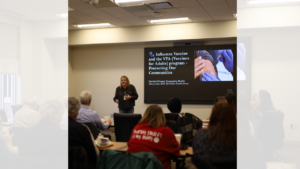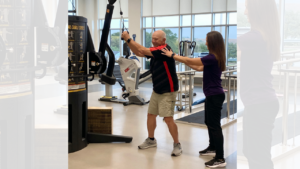The Freedom from Smoking program begins at CCMH on Tuesday, January 16 at 7:00 pm. Each weekly session runs approximately 90 minutes depending upon class size. The cost for the program is $25. Anyone who has further questions regarding the program, or who wishes to participate, can call the switchboard at CCMH, 712-265-2500.
“There is both a physical dependency to the nicotine addiction, which is one of the more difficult addictions to break, and psychological dependencies.”
That’s according to Patrick Stevens, Director of Cardiopulmonary Services at Crawford County Memorial Hospital. He is a 40-year veteran of collaborating with people who have respiratory health issues. Stevens’ work also includes helping people who have a tobacco use addiction find a way to break the habit.
“I’ve found that smoking, in particular, becomes very habit-forming. You get up in the morning and you drink your first cup of coffee, and you pick up a cigarette. You answer the phone, and you pick up a cigarette or you get in the car, and you pick up a cigarette. Those are difficult habits to break. In our Freedom from Smoking program, we have techniques for the psychological portion of the addiction, as well as nicotine dependency drugs, to help you to break the habit.”
In his role at CCMH, Stevens works with patients for all things involving the heart and lungs. He focuses specifically on the lungs at CCMH, doing all the nebulizer treatments in the hospital. Stevens assists in emergent situations especially cardiac arrest. He also oversees cardiac monitoring and EKGs. He uses a variety of cardiac monitors and if someone has a respiratory emergency, he’s the one they call.
“The ‘Freedom from Smoking’ program is designed by the American Lung Association. The program has been around for over 20 years, and I am a certified instructor. The program consists of eight sessions held over seven weeks. In the first two weeks, we talk about smoking habits and what triggers someone to smoke, and when they smoke, and why they smoke. We’ll also determine if you’re ready to quit smoking because you have to be at the right place psychologically to be ready to quit. The third session will be quit day. We have techniques we’ll introduce there so that when you leave class on the third day you’ll be done smoking. The third week is the only week we meet twice just because of quit day. So, we’ll meet again two days later to give additional support and address any issues people may be having. And the rest of the sessions are designed to provide support and resources and techniques to keep you from going back to smoking.”
Stevens says while we develop a physical dependency on nicotine, it’s actually the psychological dependency that is more difficult to overcome.
“If you have a habit, actually any kind of habit that you want to change, you have to replace it with another habit that actually is better for you. It can be exceedingly difficult to find that replacement habit that you can replicate under similar circumstances.”
While the program is targeted toward cigarette smoking, Stevens explained the program can be applied to all tobacco products.
“If you chew tobacco and want to quit, this is a good class for you. Recently, vaping has become a thing and that is also addressed because vaping is similar to cigarette smoking.”
Vaping was introduced about 10 years ago as a better alternative to smoking. Nonetheless, Stevens says it hasn’t turned out that way.
“What happened is the companies are putting stronger nicotine in the vaping devices. There’s also other things that they put into the vaping cartridges like flavorings. Vanilla and the strawberry are food flavorings, and we’re finding they’re having harmful effects on the lungs. Popcorn lung is just one example. It’s called popcorn lung because when we take an x-ray of your lungs it looks like you have popcorn in your lungs on the x-ray. Popcorn lung can become very severe, very quickly. It doesn’t take as long as the effects from cigarettes that build up over many years. If you get popcorn lung, it usually happens in two or three years or less, and it’s very debilitating.”
Stevens says sometimes people need extra help to get them over their nicotine addiction.
“There’s several nicotine replacement therapies to help wean you off the nicotine. There is the nicotine patch and there’s nicotine gum. There are also a few drugs that can be prescribed for the nicotine replacement to help you get through those cravings.”
There are a number of requirements necessary to be ready to quit, according to Stevens.
“Number one, you have to psychologically be ready. Number two, research has found the average person who was successful at quitting has to try at least six times before they’re free of the nicotine. That’s the average. On your sixth attempt, you’ll finally get free of nicotine.”
“For those people who are ready to quit, I would take a guess at about 80% success rate for the program. It’s pretty high. The other thing is also true. You can never quit quitting because even the people that have quit and been quit for many years, if you ask them, they’ll say, ‘every once in a while I get that craving and I want to have a cigarette’ so it’s a lifelong thing. Once you quit, you’ve just got to keep at it.“


